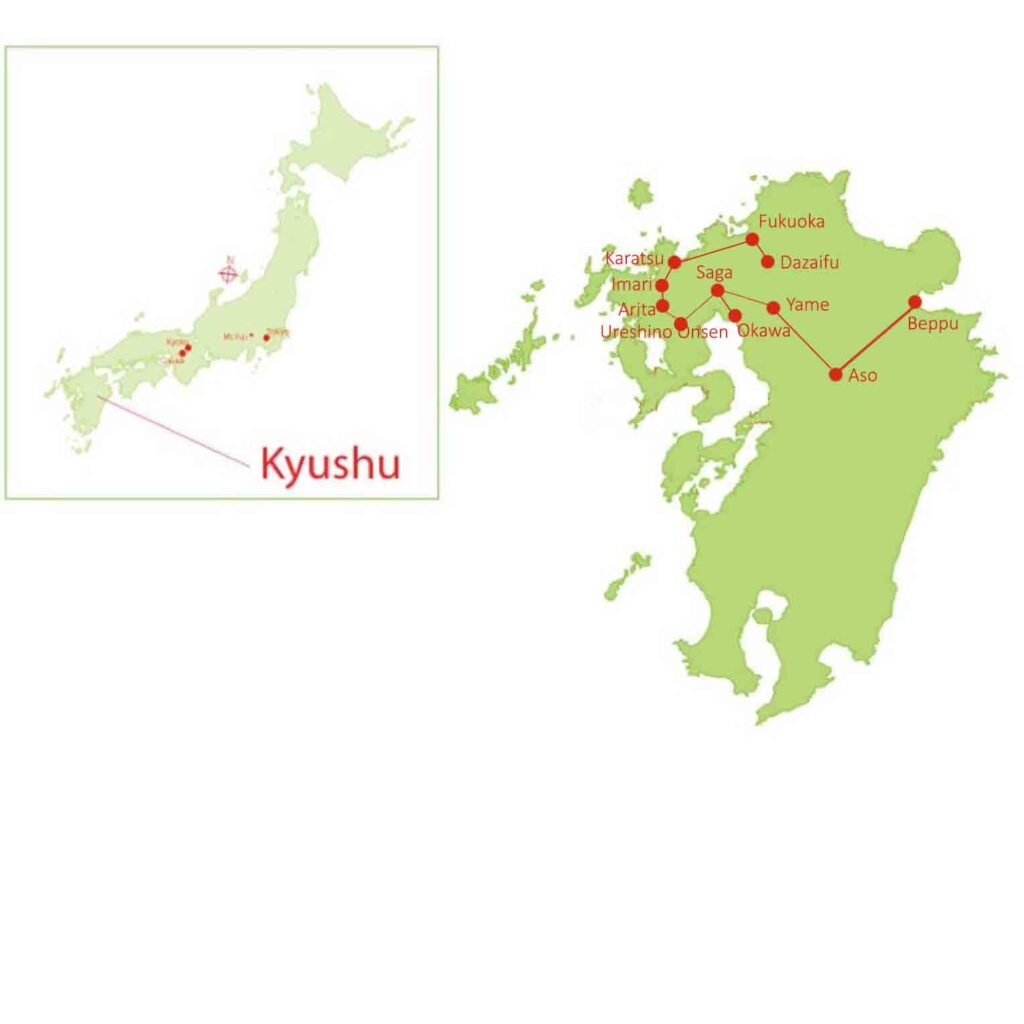Menu
2025 Artisan Tour of Kyushu Japan
2025 Artisan Tour of Kyushu Japan
Discover Japanese craftmanship at its finest on this fascinating tour of Japan’s southern island of Kyushu where you visit master artisans of pottery, textile, woodcraft, papermaking and sword making
“A top-quality, well planned & organised small group tour”
– Ross & Rosalind Hayward
Menu
ようこそ
welcome
Top Tour Highlights
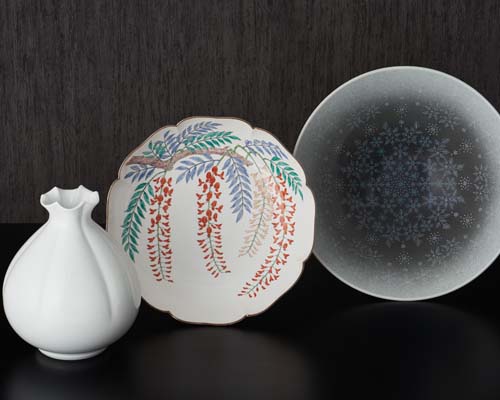
Exquisite Japanese pottery
Marvel at Japan’s sophisticated ceramic traditions in Karatsu, Imari and Arita
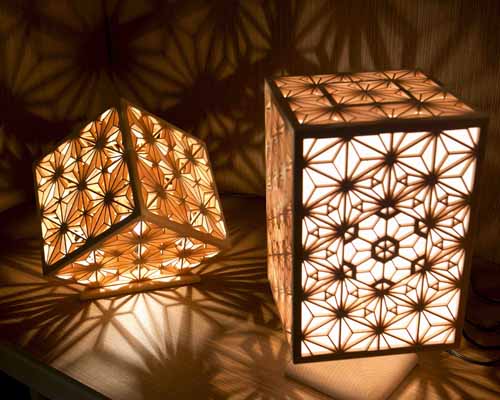
Furniture-making
Witness the exacting craftsmanship of the master furniture makers of Okawa – a celebrated woodworking town
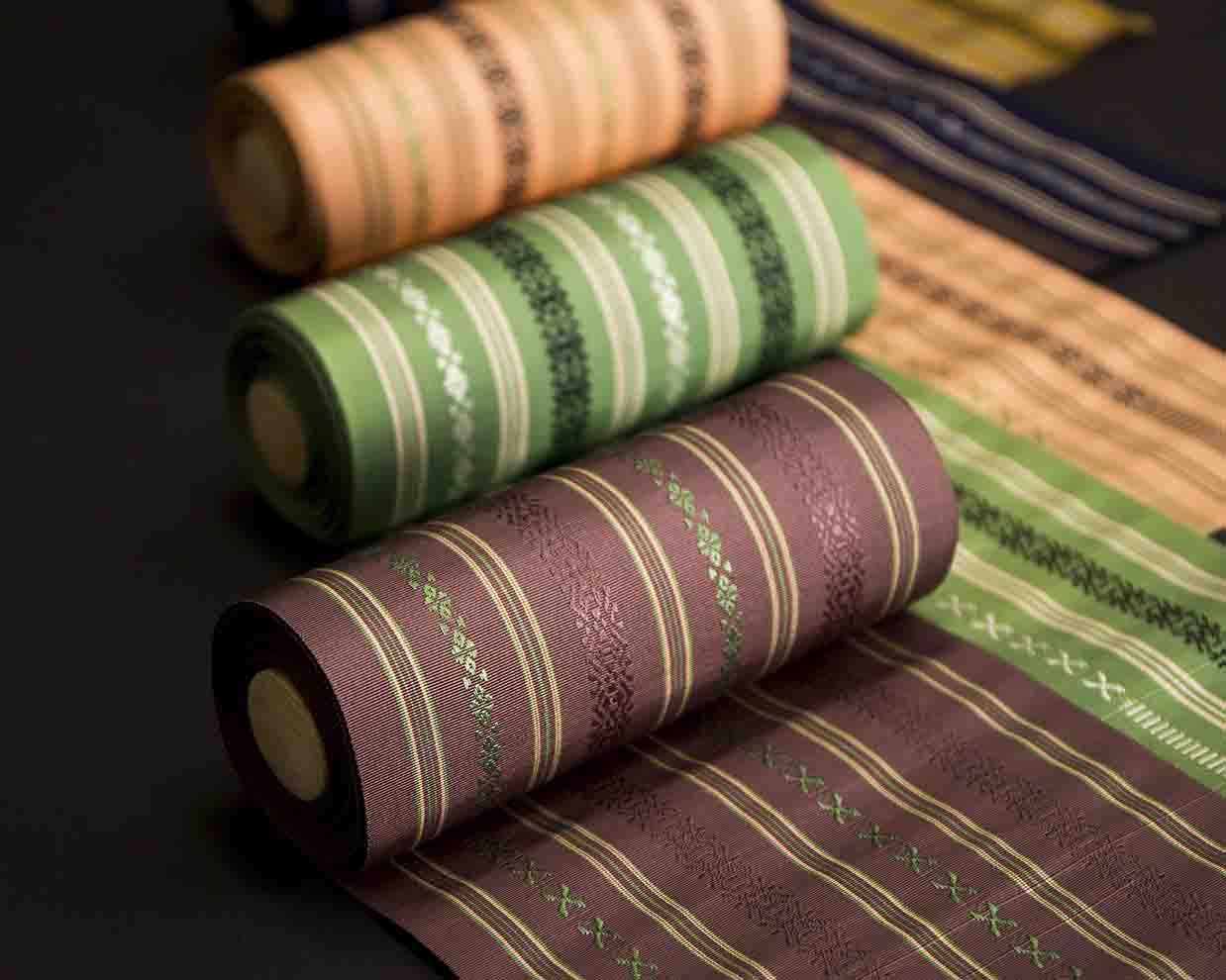
Indigo and silk kimono textiles
Join an indigo workshop in rural Yame and visit the master weavers of Hakata-ori in downtown Fukuoka
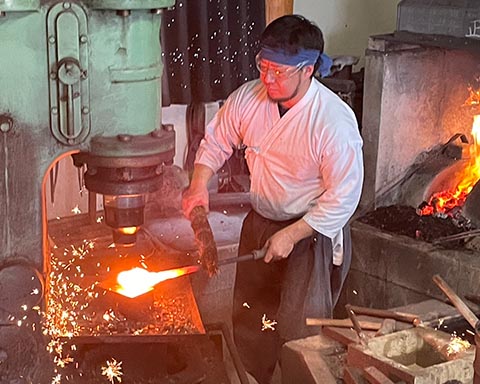
Sword-forging
Gain a rare insight into Japanese sword-making by watching a master blacksmith at work
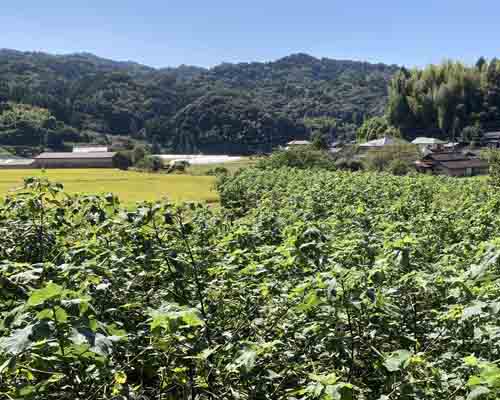
Washi-making
Learn about traditional paper-making and village life with artisans in idyllic Saga
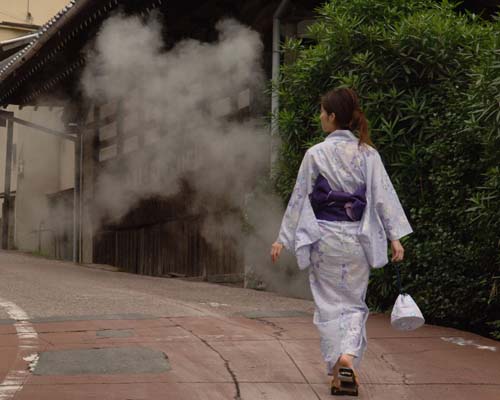
Traditional onsen culture in Beppu
Relax and rejuvenate in Japan’s most famous spa town
ようこそ
welcome
Tour Overview
This specially designed 2025 Artisanal Tour of Kyushu takes you on an exhilarating journey across Japan’s vibrant southern island to discover its deep craft traditions.
Kyushu’s proximity to China and Korea meant it served as a key entry point where ideas and goods flowed into the country. This allowed Japanese artists to adapt and refine techniques and styles, and create a distinctly Japanese form over time. In a society which celebrates its past and strong craftsman culture, Kyushu presents an ideal base to learn about these traditions, and at spring-time when the island is blessed by warm, temperate weather.
This exceptional 13-day tour will take you to destinations across Kyushu to connect with Japan’s “shokunin” – its master craftspeople. You’ll participate in hands-on sessions, where artisans across a diverse range of traditional trades explain their craft and demonstrate skills and techniques in private workshop and studio settings. You’ll visit one of Japan’s oldest weavers of silk textile, trace the birthplace of Japanese porcelain and stroll through old pottery towns, witness a master swordsmith at work over hot coals, watch as 1,000-year-old timbers are transformed into exquisite pieces without the use of nails, and see prized black bamboo woven into the most delicate basketry. You won’t find any other tour like this which specializes in Japanese crafts and covers such depth and width.
Against this backdrop you’ll also experience Kyushu’s famed hot springs culture, its celebrated seafood and premium-grade teas, and some stylish heritage accommodation and family-run traditional inns.
Deliberately curated for an intimate group of just 6 guests to allow private access to craftspeople, this boutique tour is perfect for those keen to learn more about Japan’s arts and crafts as well as experience a spectacularly scenic part of the country. With its time-honored traditions, rich history, warm hospitality and less-hurried pace of life, Kyushu ticks all the boxes.
Itinerary
Day 1: Arrival in Fukuoka
On arrival in Fukuoka for your 2025 Artisan Tour of Kyushu Japan, you’ll be met by a Journey to the East staff member at Fukuoka’s airport or main railway station and escorted to your hotel.
Fukuoka is readily accessible both by rail and air from other places in Japan, but please let us know if you need assistance arranging a connection between your arrival port in Japan and Fukuoka, or if you'd like to book an additional night’s accommodation at our Fukuoka hotel before the tour starts.
Fukuoka (The Blossom Hakata Premier or similar)
No meals
Day 2: Fukuoka
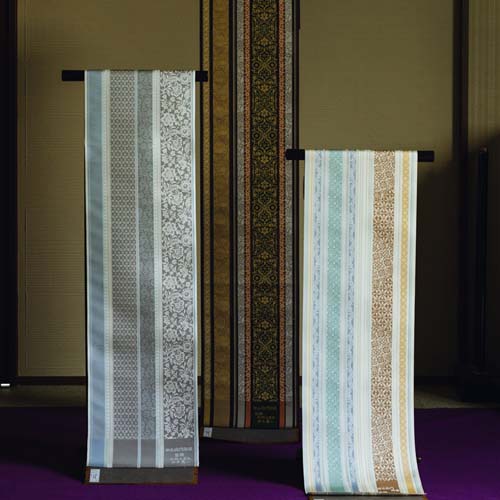
You start your artisanal tour of Kyushu by immersing yourselves in the fascinating world of Japanese textiles , in particular "Hataka-ori" silk kimono fabric.
Silk textiles from China were first introduced to Kyushu by merchants 800 years ago and over time evolved into a distinct style of Japanese textile known as “Hakata-ori”. Highly regarded, Hakata-ori was used as a tribute gift for Tokyo’s ruling elite during feudal times and remains popular today for its historical legacy, ribbed texture and lustrous finish.
Firstly in the morning, you are taken on a guided tour of the historic streets of Hakata’s old town, learning more about its intriguing past and textile traditions. You stroll past craft shops and textile studios and machiya townhouses once busy weaving hubs, and wander the grounds of ancient temples and shrines.
In the afternoon, you will visit one of Japan’s oldest weaving companies, and have the chance to observe master craftsmen at work behind hand-operated and mechanised looms and learn about design motifs and colours that trace back to the Song Dynasty of China (960 - 1279).
Over a welcome dinner tonight you have your first chance to try Kyushu’s celebrated seafood, freshly caught from local waters!
Fukuoka (The Blossom Hakata Premier or similar)
Breakfast, Lunch, Dinner
Day 3: Dazaifu
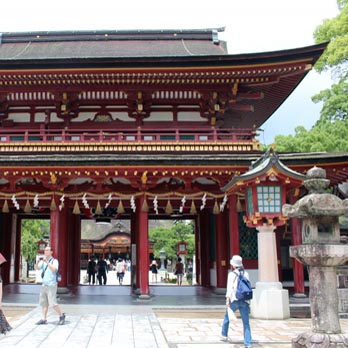
Today you journey by train to historical Dazaifu on Fukuoka’s city edge. Dazaifu is most famous for the magnificent Tenmangu Shrine (dating back to 905) which commemorates the life of one of Japan’s most celebrated scholars. This morning you will have an unique opportunity to be lead by a shrine priest for a private viewing of religious arts at Dazaifu.
Next to the shrine is the Kyushu National Museum, one of Japan’s only four national museums. This contemporary museum provides an excellent overview of Japan from pre-historic to modern times, with a particular focus on its cultural ties with Asia. Dazaifu itself was once the administrative centre for the entire Kyushu region, and through the port at Fukuoka, flourished as Japan’s key trade gateway for goods from Asia and later Europe.
Back in central Fukuoka, this evening is free for you to soak up more of the atmosphere of this vibrant, historic city.
Fukuoka (The Blossom Hakata Premier or similar)
Breakfast, Lunch
Day 4: Beppu
cropped-and-resized.jpg)
This morning you transfer to Beppu with its trademark wafts of geothermal steam. An onsen town from ancient times, Beppu became popular among wounded samurai warriors seeking recuperation in its therapeutic waters during wartime conflicts. Visitation increased over subsequent centuries as folk across Japan journeyed to Beppu to treat different ailments, staying for extended periods. This “hot spring therapy” continues to draw visitors today.
Bamboo crafts have been a traditional craft in Beppu since ancient times. Mythology suggests that a visiting Japanese emperor was first impressed by the quality of the local “madake” bamboo some 2,000 years ago and since then the industry developed, flourishing during the boom times of the late 19th century. Today the Beppu bamboo basketry industry is officially designated a traditional heritage craft.
Here you visit Beppu’s Traditional Bamboo Craft Center to trace this history and admire the detail and elegance of a range of fine bamboo-ware and basketry. You then participate in a bamboo-weaving workshop to create a small basket ourselves.
Then it’s on to experience the full geothermal force of Beppu with a walking tour of the famous “Hells of Beppu”. These are naturally-formed bubbling hot pools with temperatures exceeding 100 degrees Celsius, each with a different natural mineral make-up and smell.
Your onsen ryokan is located in the old-town district of Kannawa, one of the eight hot-spring areas of Beppu. This evening take time yourself to relax and rejuvenate in the ryokan’s onsen baths and calming Japanese-style surroundings.
Beppu (Yanagiya or similar)
Breakfast, Lunch, Dinner
Day 5: Beppu
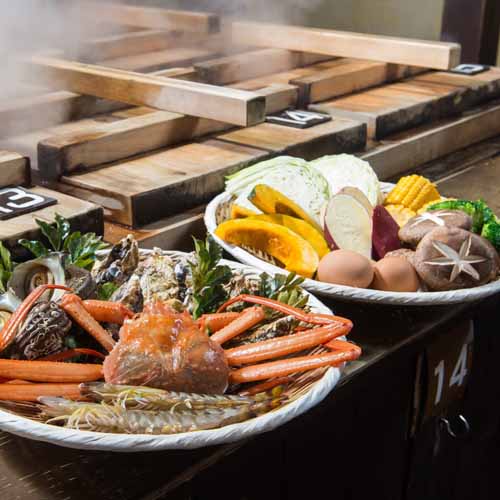
On your 2nd day in Beppu you visit an intriguing bamboo factory and watch up-close as workers process bamboo for use by craftspeople in the bamboo and basketry trades. The factory sources locally grown bamboo species (some up to 10 to 15 metres high), processing around 200 canes a day using old sustainable techniques. You’ll see different bamboo species boiled in a soda formula, or fired and dried in the sun, before the natural surface oil is wiped off and the bamboo polished for slicing into different lengths and forms.
In addition to its onsen culture, Beppu is a vibrant arts hub hosting a variety of international and local festivals and events through the “Beppu Project” initiative. This afternoon you explore the old Kiyoshima Apartment building which is home to art residencies and public art workshops, as well as some public neighbourhood baths with their retro feel and mural art.
In the afternoon enjoy some free time to further explore Beppu’s unique onsen culture. Consider some onsen therapy by covering yourself in hot sand on the beach (another traditional practice) or an herb-infused bath.
Tonight you have “jigoku mushi” (literally, hell-steaming), Beppu’s most famous dish for dinner. This is a cuisine-style passed down over centuries which uses the natural power of the hot springs. Freshly harvested vegetables, seafood and meat are gathered in traditional bamboo baskets and steam-cooked above geothermal outlets. Not only delicious, it's also incredibly healthy as the ingredients absorb the natural minerals contained in the steam and without the use of any cooking oil. With no gas or electricity, it’s 100% ecologically sustainable as well!
Beppu (Yanagiya or similar)
Breakfast, Dinner
Day 6: Takeda and Mt Aso
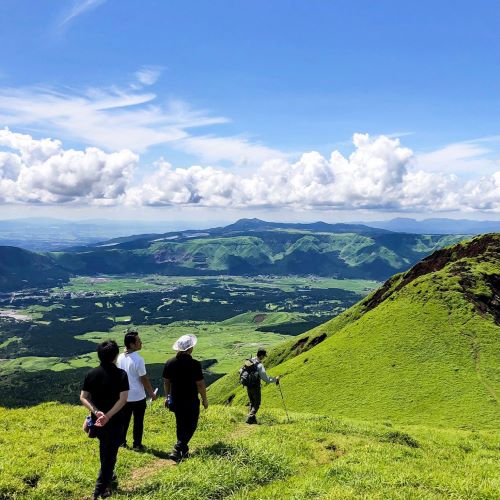
You leave the famous onsen town of Beppu this morning, and drive through one of Kyushu’s most picturesque landscapes – the volcanic caldera of the Aso-Kuju National Park in central Kyushu. But before that a special experience awaits.
In many ways the Japanese sword sits at the pinnacle of Japanese craftsmanship and today you find out why. In rural Oita Prefecture you attend a private session with a master swordsmith to see how a lump of steel ingot is forged into a form which, after months of hammering, polishing and sharpening, eventually transforms into gleaming, finely curved blade. Not only highly trained technicians, these craftsmen hold deep cultural knowledge about the symbolism and evolution of the Japanese sword over some 1,000 years. In this experience you’ll engage firsthand with this amiable swordsmith and come away with a renewed reverence for the art form.
While in the Aso highlands, you’ll stop to enjoy some taiko drumming by world-renown group Drum Tao, performed on a custom-built, open-air stage surrounded by a vast panorama of mountains and grasslands. Exhilarating on so many levels!
You will stay at another popular onsen town of Kurokawa and enjoy a typical ryokan experience tonight.
Kurokawa Onsen (Kurokawaso or similar)
Breakfast, Dinner
Day 7: Yame
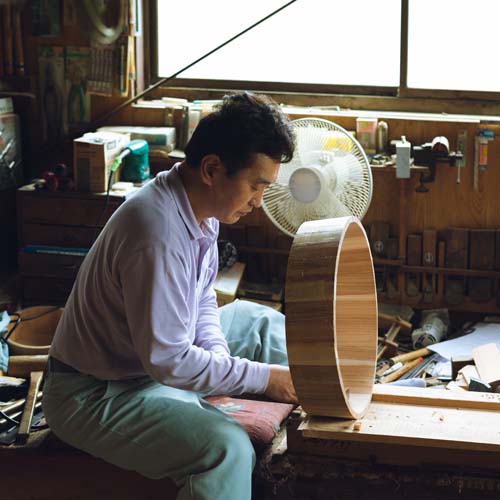
This morning you transfer to picturesque Yame, located in southern Fukuoka Prefecture.
Yame has long prospered due to its natural resources, proximity to key transport routes and 600-year heritage as one of Japan’s leading tea producers. Many traditional industries which have disappeared from other remote areas have flourished and remain a key part of the city’s character.
You begin your exploration of Yame’s traditional crafts by a guided walking tour of the old town. Designated an Important Preservation District, the area features rows of white-walled townhouses with wooden latticed shopfronts. On your walk you visit:
- A maker of butsudan – these are highly decorated Buddhist altars which are traditionally used in Japanese homes as memorials to family ancestors
- A maker of paper lanterns (chochin) – this maker uses a pliable and durable local washi paper (Kyushu’s oldest) which is stretched across bamboo frames
- Kyushu’s oldest tea merchant – here you relax over a cup of Yame “gyokuro” tea (the highest grade of Japanese tea) in a nostalgic teashop
After lunch, you visit a master maker of traditional buckets and ladles constructed from wood and bamboo without any nails. The skills required to bend and shape the wood to best accent the grain while simultaneously creating a beautiful water-tight product are exemplary.
For a unique accommodation experience over the next two nights, you stay in a renovated former sake brewery in the preservation district. A boutique hotel group has been working with local communities to sensitively renovate old daimyo residences and merchant houses. Delight in its stylish 100-year-old timber interiors and soak in a bath infused with Yame tea leaves!
Yame (Nipponia Yame Fukushima or similar)
Breakfast, Lunch, Dinner
Day 8: Yame
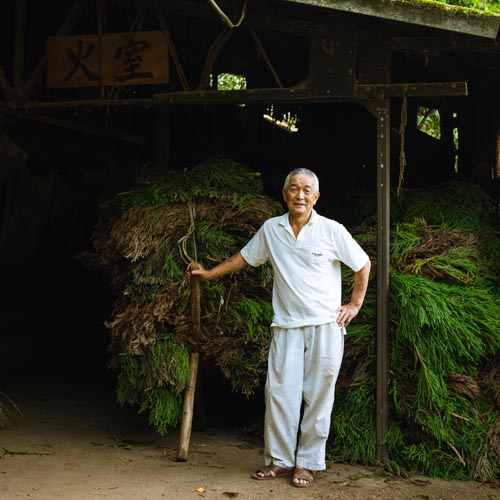
Admirers of Japanese indigo will relish the opportunity to spend the morning with a 5th generation indigo artisan.
“Japan blue” is the quintessential colour of Japan. Its deep intensity comes from an elaborate production process evolved since ancient times. After repeated stages of fermenting and drying the leaves of the Japanese indigo plant, hand-woven yarn is dyed, multiple times, in large vats of indigo liquid before being woven. Today you’ll learn about the traditional labour-intensive approach still used by this studio, as well as more modern-day methods. You’ll also be introduced to “Kurume kasuri” weaving traditions unique to this part of Kyushu.
This afternoon you have a similarly unique opportunity to learn about Kyushu incense. The way of the fragrance (“kodo”) is one of Japan’s three classical arts alongside the tea ceremony (“sado”) and ikebana (“kado”). For centuries the Japanese have used scented woods to purify and to focus and calm the mind, well before mindfulness and aromatherapy arrived in our modern lives!
You visit an incense workshop where the custom of creating pure cedar wood powder for incense sticks continues. Using sustainable cedar wood sourced from local forests, cedar leaves are dried and ground into fine powder in an old watermill, a process entirely powered by water. Yame once supported some 40 mills which supplied high-quality cedar powders to incense makers across Japan.
On the way home, you drive through the rolling green hills of Yame’s tea plantations and stop by the ancient wisterias at Susano Shrine to see a spectacular display of purple blooms.
In the evening enjoy some free time in the relaxed ambience of your heritage accommodation or stroll the old town and stop by a local izakaya.
Yame (Nipponia Yame Fukushima or similar)
Breakfast, Lunch
Day 9: Okawa
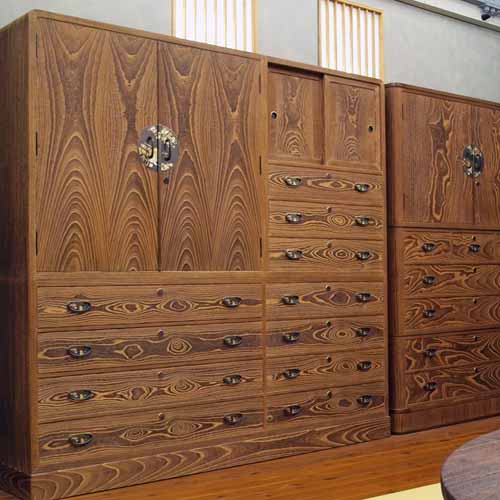
Today you continue your exploration of Kyushu’s rich 'maker' culture with a focus on its woodcrafting traditions. First stop is the town of Okawa, located just over the border in Fukuoka Prefecture.
For over 450 years, Okawa has been a woodworking hub and Japan’s largest producer of furniture, celebrated nationwide for its sophisticated craftmanship and quality. It’s still home to master carpenters and boutique makers who attract worldwide attention for blending age-old techniques with leading-edge design.
You visit one unique company which specializes in crafting pieces from the rare and beautiful Yakusugi cedar, found on Kyushu’s World Heritage island of Yakushima. While the felling of these precious 1,000-year-old trees ended years ago, this Okawa company was one of the few woodworkers permitted to purchase felled or buried stumps and limbs.
“Kumiko” is a style of decorated wooden paneling which originated in Kyushu, and here in Okawa you visit a company specializing in this beautiful joinery technique. Finely shaved pieces of wood are assembled in elaborate geometric patterns without the use of nails. The panels typically adorn traditional interiors and serve the dual purpose of allowing air flow and light distribution, while elegantly creating a sense of privacy and separation.
The hilly terrain and clear waters of Saga provide ideal conditions for Japanese paper-making and we visit a rural village where this traditional industry once flourished. We stop by one of the remaining makers which applies 300-year-old techniques to create a beautiful handmade washi, known for its unique thinness and strength. Its durability is largely due to the use of long fibres from the native mulberry tree. After being taken on a walk to learn about village life, your hosts guide you through your own washi-making experience incorporating wildflowers picked on our walk.
You stay in a city of Saga and try highly prized Saga brand wagyu beef.
Saga (Garden Terrace Saga or similar)
Breakfast, Lunch, Dinner
Day 10: Saga and Ureshino Onsen
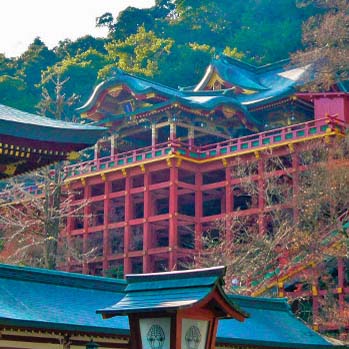
This morning you head to the grand Yutoku Inari Shrine to admire the sophisticated carpentry needed to construct this magnificent hillside building. One of Japan’s top three shrines dedicated to the Shinto god of Inari, the vermillion-red main structure rests on towering 14m-high columns.
For another perspective on how Japanese designers have superbly incorporated the natural environment into their built structures, you stop by Mifuneyama Rakuen Gardens at the foot of Mt Mifune. A rural retreat for the local Nabeshima clan, the garden was ingeniously designed to encapsulate the mountain as part of its “borrowed scenery”. In spring, azaleas break out in spectacular waves of colour.
After a full, inspiring day, you spend the night at the nearby spa town of Ureshino. The mineral hot springs at this onsen are known for their clear waters and smooth, silky feel on the skin. The tranquil riverside setting and timeless aesthetic of traditional tatami rooms make for a perfect onsen stay.
Ureshino Onsen (Shibasanso or similar)
Breakfast, Dinner
Day 11: Arita and Imari
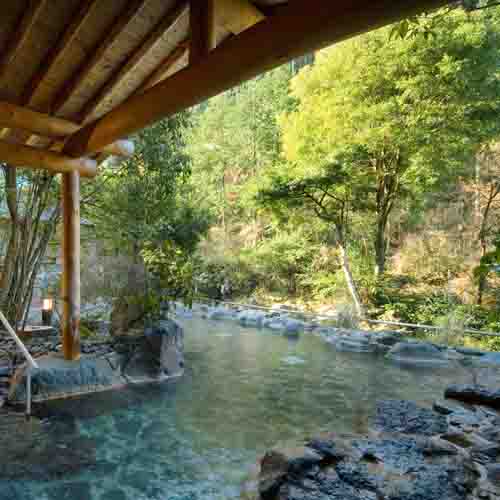
This morning you head to pottery towns of Arita and Imari, each with their own unique styling. Our focus for the next two days is ceramic traditions.
Your first stop is the town of Arita, the birthplace of Japanese porcelain. Kaolin, the essential material used in porcelain clay, was discovered in Arita’s hills in the early 17th century. You tour the original quarry before visiting the superb Kyushu Ceramic Museum. With over 30,000 exhibits, the museum provides a comprehensive introduction to its ceramic arts. Afterwards you visit some of Arita’s leading studios and galleries (some featuring the celebrated works of “Living National Treasures”) and soak up the historic atmospheric. You then move to the fascinating village of Okawachiyama, nestled between steep mountains and known as the “Village of Secret Kilns”. The village was purposely set up in the 17th century by the local Nabeshima clan to exclusively produce porcelain for Japan’s imperial court and ruling elite. Its remote location allowed artisans to refine production techniques, which they zealously guarded and protected. Today Imari Nabeshima-ware is thankfully available to all, while its high-end status and exquisite quality remain unchanged.
Finally you reach the pretty castle town of Karatsu, another famous pottery town. Tonight’s accommodation is a warm and welcoming traditional ryokan in a delightful garden setting. The inn displays the works of Karatsu potters, including an onsite gallery. Enjoy a delicious multi-course kaiseki banquet, served of course on superb Karatsu-ware!
Karatsu (Ryokan Yoyokaku or similar)
Breakfast, Lunch, Dinner
Day 12: Karatsu
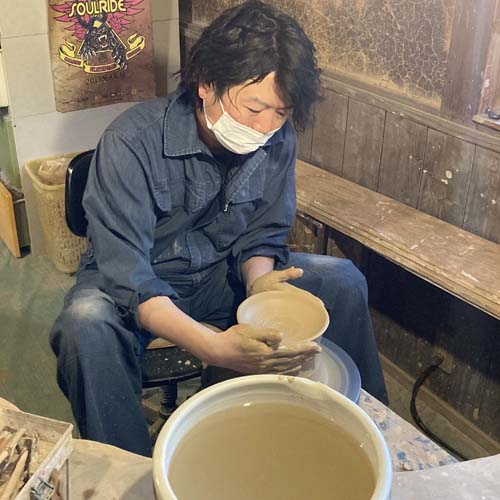
While the foundation of Japan’s ceramics originated in China and Korea, Kyushu artisans adapted and refined ceramic-making techniques over hundreds of years to develop a distinctly Japanese aesthetic. This not only influenced the subsequent development of ceramics in other parts of Japan but also in Europe, where early traders found a ready market among the European nobility. Today Kyushu ceramics still rank among the world’s best.
This morning you start your exploration with a visit to a traditional pottery studio, which has remained in the same family for 400 years and currently headed up by the 14th generation owner. You tour the studio’s beautiful memorial museum to see its exquisite collection of old Karatsu-ware, celebrated for its simple elegance and natural tones.
The rest of the day is spent touring another historic Karatsu kiln owned by another old pottery family. You’ll be introduced to the processes of making Karatsu-ware, and tour its fascinating “nobori-gama” multi-chamber climbing kiln. Guided by expert artisans, you’ll also participate in a dedicated workshop to create your own piece of Karatsu-ware.
Tonight you will drive back to Fukuoka for your farewell dinner.
Fukuoka (The Blossom Hakata Premier or similar)
Breakfast, Lunch, Dinner
Day 13: Goodbye in Fukuoka
You check out of your hotel after breakfast and your 2025 Artisan Tour of Kyushu Japan concludes.
For travelers departing Japan from Tokyo, you can take a domestic flight from Oita Airport to Haneda or Narita airports. Or if you’d like to linger in Kyushu or Japan a little longer, we would be delighted to help plan your personal post-tour extension. Please see our Model Extension Itineraries for inspiration.
Note: The cost of a transfer to your departure airport is not included in our tours as we found many guests choose to stay in Japan a bit longer. However, we would be happy to arrange a transfer to your next destination or departure airport if needed. Please see our FAQ for more details.
Breakfast
Dates & Prices
2025 Artisan Tour of Kyushu Japan
Per person twin share:
Single supplement
Inclusions
Each guest is personally looked after with one-on-one interactions with our hand-picked, expert tour guides. As part of your investment, this tour includes:
- First-class wisdom and higher standard of individual care and attention
- 12 nights’ accommodation (including traditional Japanese inns)
- All breakfasts
- 8 lunches (3 free choice lunches)
- 9 dinners (2 free choice dinners)
- Airport meet & greet on arrival
- All local transport (train and private minivans)
- Expert English speaking tour guides (locally licensed)
- Cultural activities and entry fees included in itinerary
DISCLAIMER: Unless otherwise stated, this tour does not include the costs of international and domestic airfares, transfers on the last day, travel insurance, alcoholic and non-alcoholic beverages, transport during free time, personal expenses (laundry, internet, telephone, coin lockers etc.) and Visa (if required).
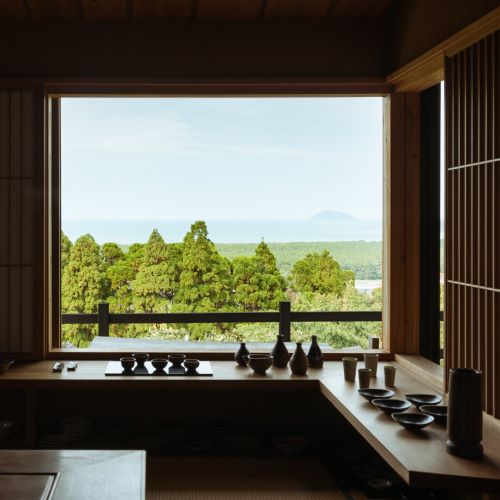
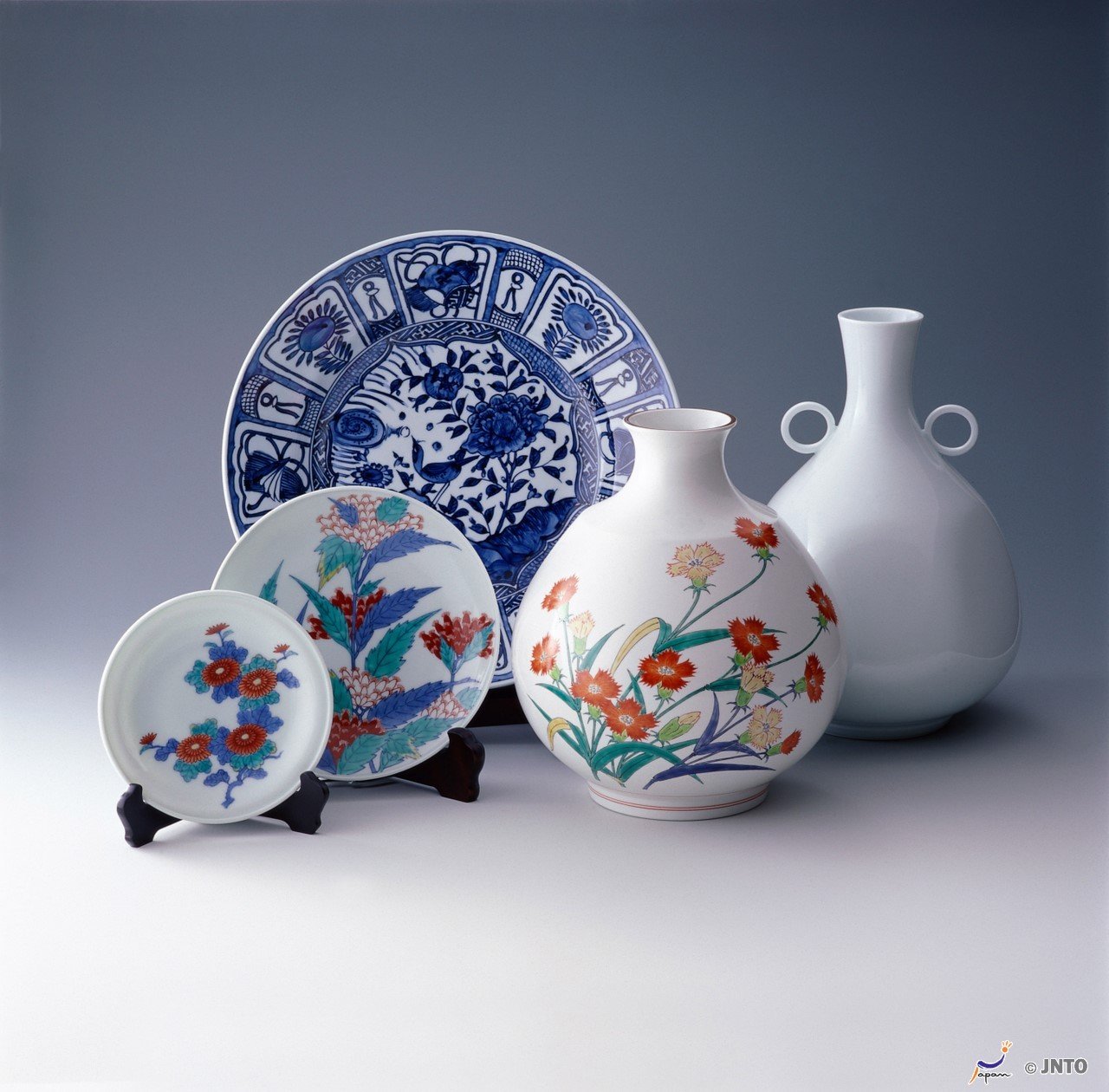
Who this Japan tour is for...
This is a perfect tour for people who:
- Appreciate Japanese artistic traditions and the superb level of craftmanship
- Wish to explore less-visited destinations away from the mainstream tourist hubs
- Enjoy the format of a professionally researched and organised extra small group tour led by an expert guide who can share insights and provide personalised support
- Are seeking an active and authentic Japan experience where local food, accommodation and onsen culture can be fully enjoyed
- Love to discover Japan’s natural landscapes, such as its sea and rivers, volcanic landscapes and mountains
- Prefer a relaxed small group format with a variety of accommodation and meal types and some free time to do their own thing
*Some photographs are provided by Koichiro Fujimoto and Saga Prefectural Tourism Federation
